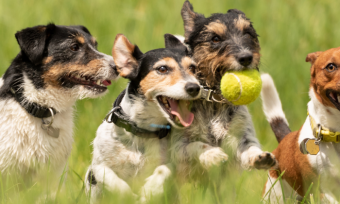Unfortunately, natural emergencies are part of life in New Zealand. But if one occurs, do you know how to keep your pet safe? The pet experts at PD Insurance cover all you need to know about how to protect your pet if there’s a natural emergency.

Emergency preparedness and response for pets is exactly what it sounds like. It’s planning how to safeguard your pet before an emergency occurs.
We all know prevention is better than cure. But while you can’t prevent an emergency, planning for one is the next best thing. In this article PD Insurance unpacks tips for how to respond to common pet emergencies:
Emergency preparedness and response for pets
Pets have a fight, flight or freeze response that kicks into action when facing danger (or perceived danger). So one of the first things they do when facing an emergency or disaster is to run away.
This means pets often become separated from their families. But there are several safeguards that can prevent this from happening, and help you become reunited with your pet should you become separated.
Here’s a list of emergency preparedness and response tips for safeguarding Kiwi pets:
Don’t drop, cover and hold
This rule of thumb for earthquakes doesn’t apply to pets. Unless they’re already close enough to hold and comfort, let them find their own safety point. They’re incredibly adept at doing so, and could bite or scratch if you try holding them still.
Microchip pets
A pet microchip links the animal to all its personal information on a central pet registry, which links to you their owner. When a shelter or vet receives a lost pet, they will check for a microchip to determine the animal’s owner.
Pet collar and tag
In addition to a pet microchip, make sure your pet wears a collar and tag. This will speed up identification if a good Samaritan finds your pet. Be sure to use a safety breakaway collar for cats, too.
Keep a pic of your pet in the cloud
If you’ve had to evacuate you might not have access to your computer, phone or photo album. So keep a recent photo of your pet in online storage, so if your pet goes missing you can post it to lost pet sites.
Leave food and water
If you need to evacuate your home without your pets, leave plenty of dry food and water where they’ll be able to access it.
Pet kit on hand
Have an emergency pet kit ready and packed to go that contains basic first-aid supplies. In addition to food, water and bowls (collapsible ones are great), pack a blanket or towel to help keep your pet calm during stressful situations. Consider including poop bags, leashes and your pet carrier, and be sure to pack a copy of your pet’s medical records along with a recent snapshot.
Vaccinations up to date
Pets can be exposed to many pathogens after natural disasters. Keeping pet vaccination schedules up to date helps mitigate unwanted illness.
Pet door sign
Many people have a sign on their door saying “I live here”, featuring a picture of their pet. Such signs can alert first responders, who keep an eye out for strays and lost animals.
Compare Pet Insurance with Canstar
Looking for pet insurance that delivers great customer satisfaction? Each year, we release our Most Satisfied Customers | Pet Insurance Award and Star Ratings. Below is an abridged version of our full awards, which you can view here.
See here for our ratings methodology. The table above is an abridged version of our research. For the full results of our 2022 Pet Insurance Most Satisfied Customers Award, click here.
Common pet emergencies and how to respond
Besides understanding what’s best practice in emergency preparedness and response for natural disasters, what about other risks to pets?
The most common pet emergencies that require treatment involve infections, injuries, allergies and illnesses. Depending on the situation, there may be temporary steps you can take to treat your pets at home but, generally, pets will need an unplanned visit to the vet.
Understanding the common risks faced by pets helps emergency preparedness and response planning. Here’s a list of several common health risks for pets, each with a link through to a relevant blog on the PD website:
- What to do if my cat or dog is choking
- Accidental ingestion guide
- The ins and outs of animal CPR
- Safety measures for dog vomiting and gastro
- Preventing dog bites
- Things that can poison your pet to keep away
- Dog skin conditions







 This report was reviewed by Canstar’s Editor, Bruce Pitchers. Bruce has three decades’ experience as a journalist working for major media companies in the UK and Australasia, including ACP, Bauer Media Group, Fairfax, Pacific Magazines, News Corp and TVNZ. Prior to Canstar, he worked as a freelancer, including for The Australian Financial Review, the NZ Financial Markets Authority, and for real estate companies on both sides of the Tasman.
This report was reviewed by Canstar’s Editor, Bruce Pitchers. Bruce has three decades’ experience as a journalist working for major media companies in the UK and Australasia, including ACP, Bauer Media Group, Fairfax, Pacific Magazines, News Corp and TVNZ. Prior to Canstar, he worked as a freelancer, including for The Australian Financial Review, the NZ Financial Markets Authority, and for real estate companies on both sides of the Tasman.





Share this article